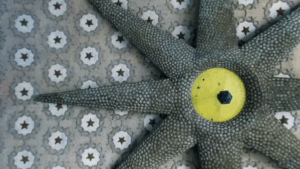July 4, 2024
By Ferran Garcés

One of the most common questions during visits is at what point in his life Gaudí built Torre Bellesguard. Is it one of his first works? Is it one of his last? The answer is that Gaudí carried out this project in the period critics consider the most innovative phase of the artist. It is the era of the header photo, taken in 1904, where Gaudí appears wearing a hat, accompanied by his father, his niece, and his friend, without a hat, Dr. Pere Santaló Castellví.
The period begins in 1900, when the architect was 48 years old, and ends in 1914, at 62. It is the period of Colonia Güell (1898-1908), Torre Bellesguard (1900-1909), Casa Batlló (1904-1906), Casa Milà (1906-1910), and Park Güell (1901-1914). An innovative and fruitful period because, in parallel, Gaudí also embarked on about thirty projects. However, some were never carried out. This is the case, among others, of two works that, if realized, would have been very close to Torre Bellesguard: the bridge over the Pomeret stream (1904-1906) and the Chalet Graner (1904). Similarly, it is the era of the failed reform of the Sanctuary of Mercy (1903) in Reus, the city where Gaudí spent his early years but where he never built any works.
Other projects, despite being completed, were destroyed, such as the decoration of the Bar Torino (1902) and a cinema called Sala Mercè (1904). A third category includes works that were left unfinished, such as the gate and wall of the Miralles house (1902), which can still be visited.
Finally, some projects have reached us but with modifications by other architects, such as the First Mystery of Glory of the Monumental Rosary in Montserrat (1900-1907), which was completed by Jeroni Martorell. The photo accompanying our article was taken during an excursion that served as a preliminary study for this work. In it, we see the only two relatives Gaudí had left: his father, Francesc, and his niece, “Roseta.” The former died in 1906 and the latter in 1912. Gaudí himself was almost about to join them at that time…
In May 1910, Gaudí fell seriously ill and had to seek rest in Vic, on the advice of friends such as Bishop Torres i Bages. The specific illness is a matter of debate. According to various authors, it was a cerebral anemia and/or a nervous depression. During the three weeks of rest, Gaudí still had the strength to design some streetlights for the host city, which were unfortunately demolished in 1924. In the summer of the following year, Gaudí contracted Malta fever, or brucellosis, and this time he went to Puigcerdà with his friend, Dr. Pere Santaló Castellví, the companion from the Montserrat excursion.
Upon returning to Barcelona, Gaudí devoted himself to the Sagrada Familia, a work that runs parallel to all the architect’s projects since he took on the commission at the beginning of his career in 1883. In fact, he died dedicated exclusively to it, on June 10, 1926, when he was about to turn 75. Pere Santaló Castellví, the other person in the photo taken when Gaudí was building Torre Bellesguard, would die five years later.
Notes
(1) You can consult the list of Gaudí’s works on the website of the Antoni Gaudí Foundation: [“List of Gaudí’s Works and Projects”].
For a more detailed compilation, we recommend the following reference: Bassegoda, Joan (1984) “Chronology of Gaudí’s Life and Work”, in Antoni Gaudí (1852-1926), Fundación Caixa de Pensiones, Barcelona, p. 237-243.
However, these lists lack a work that was unknown until recently: the garden of the old Sant Boi de Llobregat Asylum. Built sometime between 1903 and 1912, it also belongs to the period of Torre Bellesguard. This year it is the subject of an exhibition: “Gaudí’s Invisible Garden”, which can be visited at the Espai d’Arts of the MNACTEC, in Terrassa.
(2) To learn more about Gaudí’s relationship with this city, see: Garcés, Ferran (27/07/2024), [“The Bellesguard Connection with Reus”, on our blog.




